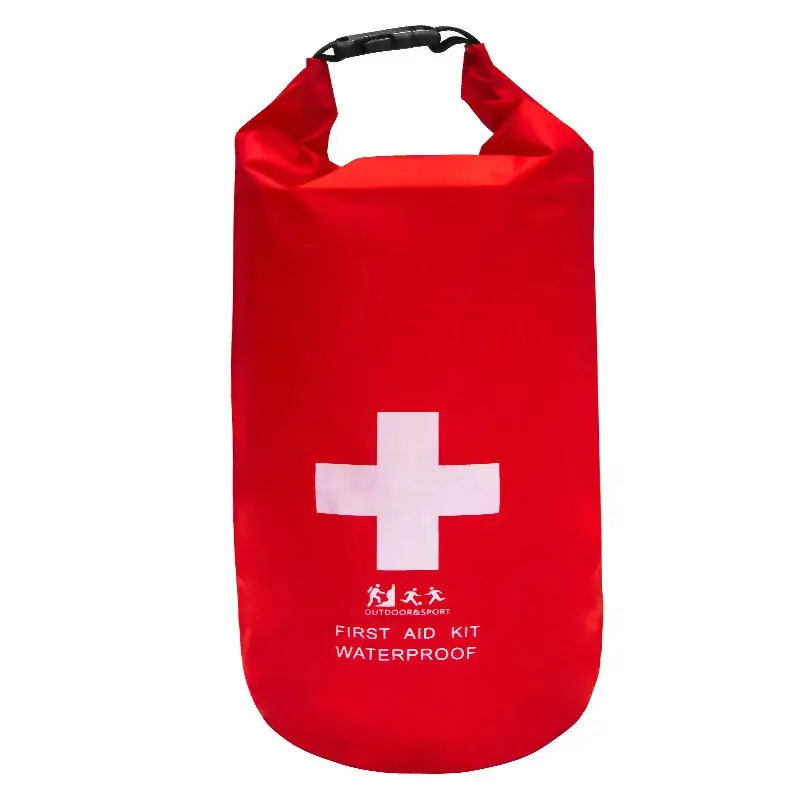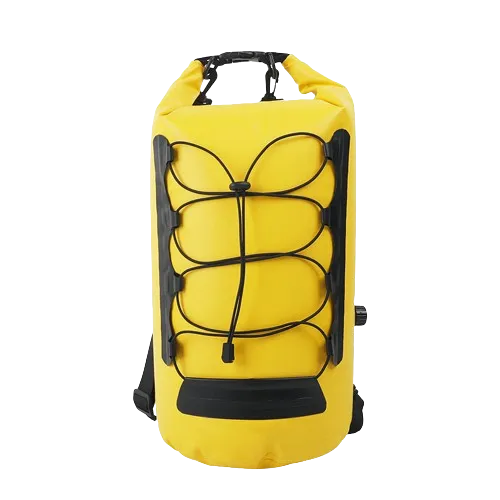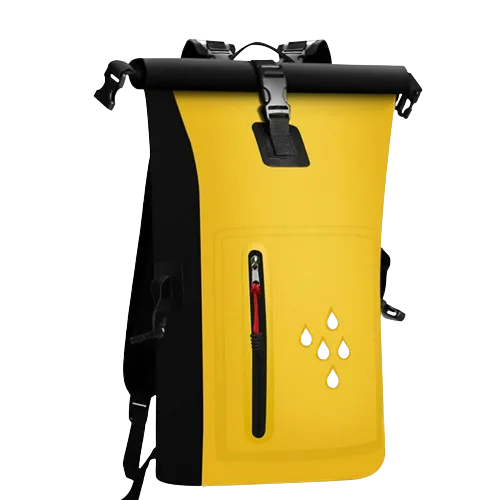Aquatic Armament: All About Waterproof Bags
- Latest update

Written by Jason
Waterproof bags have become an indispensable companion for outdoor enthusiasts, adventurers, and even everyday commuters. In a world where unpredictable weather conditions are a constant challenge, having reliable protection for our belongings is paramount. Whether you are planning a weekend camping trip, embarking on a thrilling kayaking expedition, or simply navigating bustling city streets during a rainy commute, waterproof bags offer peace of mind and ensure that your valuables remain dry and safe.
The Importance of Waterproof Bags: Shielding Your Belongings from the Elements
In the realm of outdoor activities, exposure to moisture is inevitable, and conventional bags often fail to provide adequate protection against rain, splashes, or accidental submersions. Understanding the importance of waterproof bags lies in recognizing their ability to safeguard essential items such as electronics, clothing, food supplies, and even delicate documents from the damaging effects of water. Imagine trekking through lush rainforests with your camera equipment on your back when suddenly dark clouds gather overhead.
Rain starts pouring relentlessly as you scramble for shelter. Without proper protection for your gear inside a waterproof bag, precious memories could be washed away by an unexpected downpour.
In urban settings too, the need for waterproof bags arises from our reliance on electronic devices such as smartphones and tablets which we carry everywhere we go. These gadgets play vital roles in our daily lives – storing important information like contacts and schedules – making it crucial to keep them safe from water damage caused by sudden showers or accidental spills.
An Overview of The Guide’s Purpose: Empowering You With Knowledge
This comprehensive guide aims to equip you with everything you need to know about waterproof bags – from understanding their features and types to choosing the right one based on your specific needs. By delving into the intricacies of construction materials and closure mechanisms, you will gain valuable insights into assessing the quality and durability of waterproof bags.
Furthermore, this guide highlights popular brands and their offerings to help you make informed decisions when it comes to purchasing a waterproof bag. Whether you are a seasoned adventurer or a novice explorer, our goal is to ensure that you can navigate through the vast array of options available in the market and find the perfect waterproof bag that suits your lifestyle.
So, let us embark on this journey together – where knowledge merges with practicality, enabling you to embrace any adventure or daily routine without worrying about water damage. Let’s dive into the realm of waterproof bags and unlock the secrets to their effectiveness and superiority over traditional bags.
Understanding Waterproof Bags
The Definition and Characteristics of Waterproof Bags
Waterproof bags are ingenious inventions designed to protect your belongings from water damage in various situations. Whether you’re embarking on a thrilling adventure or simply bracing for inclement weather, these bags offer unparalleled protection against moisture and ensure the safety of your valuables.
The key characteristic that sets waterproof bags apart is their ability to create an impermeable barrier that prevents water from seeping inside, even when fully submerged. Unlike water-resistant bags, which offer limited protection against moisture, waterproof bags are specifically engineered to withstand prolonged exposure to water.
Differentiating Between Water-Resistant and Waterproof Materials
It is crucial to understand the distinction between water-resistant and waterproof materials when seeking reliable protection for your belongings. Water-resistant materials such as nylon or polyester repel water to a certain extent but may eventually allow moisture penetration under continuous exposure or heavy rain. On the other hand, truly waterproof materials like PVC (Polyvinyl Chloride) or TPU (Thermoplastic Polyurethane) offer an impenetrable barrier against liquids, ensuring absolute dryness within the bag’s confines.
How Waterproof Bags Are Constructed
The construction of a waterproof bag involves meticulous attention to detail and the integration of specialized techniques and materials. The most common construction method utilized in manufacturing waterproof bags is high-frequency welding or heat sealing.
This process involves using radio frequency waves or heat application to bond the bag’s seams together, creating a watertight seal. Heat sealing ensures there are no needle holes or stitching points that could potentially compromise the bag’s ability to keep water out.
The material used in constructing waterproof bags plays a pivotal role in their efficacy. PVC and TPU are popular choices due to their inherent resistance against both abrasion and hydrostatic pressure—the force exerted by water.
These materials provide the necessary flexibility and durability required to withstand constant use and exposure to various weather conditions. Additionally, some waterproof bags incorporate reinforced patches or layers in high-stress areas to enhance their overall strength and increase resistance against wear and tear.
Moreover, the closure mechanism of a waterproof bag contributes significantly to its effectiveness. Roll-top closures, often seen in dry bags, involve rolling down the opening of the bag several times before securing it with buckles or clips.
This creates a watertight seal that prevents water from entering through the top opening. Some waterproof backpacks employ zipper closures coated with water-resistant materials such as rubber or silicone for added protection against moisture infiltration.
Understanding these fundamental aspects of waterproof bags equips you with the knowledge necessary to choose a reliable option that suits your needs. Now that we have established a solid foundation, let’s dive into exploring the various types of waterproof bags available in the market and their unique features.
Dry Bags: Where Waterproof Meets Versatility
When it comes to keeping your belongings safe and dry in the great outdoors, dry bags are an adventurer’s best friend. These ingenious creations offer a range of features and benefits that make them an essential piece of gear for outdoor enthusiasts.
One of the most notable advantages is their ability to keep your belongings completely dry, even in the harshest weather conditions or when submerged in water. Dry bags come in a variety of sizes, shapes, and designs, catering to different needs and preferences.
Whether you’re looking for a compact bag to hold just your essentials or a large one for extended camping trips, there is an option available for everyone. Some dry bags feature roll-top closures that create an airtight seal when folded correctly, ensuring maximum waterproof protection.
Others may incorporate additional features like adjustable straps or external pockets for added convenience. These versatile bags find their best applications in activities such as camping, kayaking, hiking, and any situation where exposure to water is expected.
Kayakers appreciate the peace of mind offered by storing their food, electronics, and extra clothing items in trustworthy dry bags during water-based adventures. Hikers can confidently tackle trails knowing that their sensitive gear won’t be ruined by unexpected rain showers or accidental submersion.
Waterproof Backpacks: Embrace Practicality with Style
If you’re someone who values both functionality and style when it comes to outdoor gear, then waterproof backpacks are worth considering. These backpacks not only provide the same level of protection as dry bags but also offer additional advantages that regular backpacks lack. The primary advantage of using a waterproof backpack over a regular one is its ability to keep all your belongings completely dry even when exposed to heavy rain or soaked conditions.
This makes it ideal for activities like commuting to work or school during rainy seasons or taking your laptop and documents on a boating trip. With a waterproof backpack, you can bid farewell to the constant worry of water damage.
When choosing a waterproof backpack, consider factors such as capacity and compartments. Assess your needs and select a size that suits you best – from compact daypacks to spacious multi-day backpacks.
Additionally, look for features like padded laptop sleeves, external attachment points for extra gear like trekking poles, and strategically placed pockets for organizing smaller items efficiently. Several reputable brands specialize in manufacturing high-quality waterproof backpacks.
These include industry leaders like Patagonia, The North Face, Osprey, and SealLine. Each brand offers unique designs tailored to different uses and preferences – from minimalist designs for ultralight backpacking to urban-focused styles blending practicality with fashion-forward aesthetics.
Investing in a reliable waterproof backpack not only protects your valuables but also adds functionality and style to your outdoor adventures or daily routines where weather conditions may be unpredictable. With the right choice of waterproof bags, you can embark on new adventures without compromising on either form or function.
Material Quality:
An Overview of Common Materials Used in Waterproof Bags: PVC and TPU
Choosing the right material for your waterproof bag is crucial to ensure its effectiveness and longevity. Two commonly used materials in the manufacturing of waterproof bags are Polyvinyl Chloride (PVC) and Thermoplastic Polyurethane (TPU). Each material has its own set of advantages and disadvantages, which should be considered before making a purchase.
PVC, a popular choice for waterproof bags, offers excellent water resistance and durability. It is known for its strength and ability to withstand harsh conditions.
PVC can withstand exposure to sunlight without degradation or discoloration. However, one drawback of PVC is its environmental impact as it is not biodegradable and can release harmful chemicals during production.
On the other hand, TPU is a more environmentally friendly alternative to PVC, as it is non-toxic and recyclable. TPU provides great flexibility while maintaining durability.
It also offers resistance to oil, abrasion, and UV radiation. However, compared to PVC, TPU may have slightly lower water resistance.
When choosing between PVC and TPU for your waterproof bag, consider the intended use of the bag along with your personal preferences regarding environmental impact. Both materials have their merits, so make an informed decision based on your specific needs.
Pros and Cons of Each Material Type
To further assist you in making an informed decision about material quality when purchasing a waterproof bag, let’s delve into the pros and cons of both PVC and TPU: PVC Pros: – Excellent water resistance
- High durability – UV resistant
- Cost-effective option PVC Cons:
- Environmental concerns due to non-biodegradability – May release harmful chemicals during production
TPU Pros: – Environmentally friendly (recyclable)
- Flexible yet durable – Resistant to oil and abrasion
- Better chemical resistance compared to PVC TPU Cons:
- Slightly lower water resistance than PVC – Generally higher priced compared to PVC options
Consider these pros and cons in relation to your specific needs, preferences, and budget when choosing the material for your waterproof bag. A balanced evaluation will help you make an informed decision that aligns with your requirements.
Closure Mechanisms:
Explanation of Different Closure Mechanisms: Roll-top and Zipper
The closure mechanism of a waterproof bag plays a vital role in keeping water out and protecting your belongings. Two common closure mechanisms found in waterproof bags are roll-top closures and zipper closures.
Understanding how each works is essential in selecting the most suitable option for your needs. A roll-top closure involves rolling down the opening of the bag multiple times before securing it with a buckle or fastener.
This closure mechanism creates an airtight seal, preventing water from entering the bag. Roll-top closures are popular among outdoor enthusiasts as they provide excellent water resistance, even when fully submerged.
Additionally, they offer ease-of-use and can accommodate various load sizes due to their adjustable nature. In contrast, zipper closures rely on interlocking teeth or channels that form a tight seal when closed properly.
While zippers are commonly used in everyday bags, not all zippers are created equal when it comes to waterproofing capabilities. Waterproof zippers often feature specialized designs such as rubberized coatings or welded seams to enhance their water resistance.
When comparing roll-top closures with zipper closures, several factors come into play: Reliability: Roll-top closures tend to be more reliable due to their simplicity and lack of moving parts that could malfunction or get damaged over time.
Zippers may occasionally fail if not maintained properly or exposed to excessive stress. Ease-of-use: Roll-top closures usually require less effort since they involve rolling down the opening rather than aligning and engaging a zipper.
However, zippers offer quicker access to the bag’s contents, especially when you need to retrieve items frequently. Consider your preferences, the intended use of the bag, and the level of convenience you desire when deciding between roll-top closures and zipper closures for your waterproof bag.
Durability:
Factors Affecting Durability: Stitching Quality and Reinforcement
When purchasing a waterproof bag, durability is paramount. The bag should withstand various environmental conditions and frequent use without compromising its effectiveness. To assess a waterproof bag’s durability before making a purchase, it is essential to consider factors such as stitching quality and reinforcement.
Stitching quality plays a vital role in determining how well the seams of a waterproof bag hold together. Look for bags with double or triple stitching along critical stress points to ensure longevity.
High-quality stitching not only prevents water from seeping through but also maintains structural integrity, preventing tears or unraveling over time. Reinforcement is another crucial aspect to examine when evaluating durability.
Reinforced areas include handles, straps, attachment points, and high-stress zones where additional layers or materials are added for increased strength. Reinforcements such as reinforced bottoms or padded sections can protect against wear and tear caused by rough surfaces or heavy loads.
To assess durability before purchasing a waterproof bag:
1. Inspect the stitching carefully: Look for tight stitches with no loose ends.
Check for reinforced areas: Ensure that critical stress points have additional layers or material reinforcements. 3. Examine material thickness: Thicker materials generally offer higher durability but consider weight implications based on your needs.
Read customer reviews: Research feedback from users who have tested the bags under similar conditions to gain insights into their long-term durability experiences. By taking these factors into account during your selection process, you can choose a durable waterproof bag that will withstand the rigors of your outdoor adventures or daily use.
Maintenance and Care Tips for Waterproof Bags
Cleaning Procedures:
Keeping your waterproof bag clean is essential for prolonging its lifespan and ensuring its performance. Here are step-by-step instructions on how to clean different types of waterproof bags:
- Dry Bags:
- Start by emptying the bag and shaking off any loose dirt or debris.
- Fill a basin or sink with warm water and add a small amount of mild detergent. c. Use a soft brush or cloth to gently scrub the interior and exterior of the bag, paying extra attention to any stains or spots.
- Rinse thoroughly with clean water to remove all soap residue. e. Hang the bag upside down in a well-ventilated area, allowing it to air dry completely before storing.
- Waterproof Backpacks:
- Empty all contents from the backpack’s compartments.
- Wipe down the interior and exterior surfaces using a damp cloth or sponge. c. For tougher stains, create a solution of warm water and mild soap, then use a soft brush to gently scrub the affected areas.
- Rinse off any soap residue by wiping with clean water or using another damp cloth. e. Allow the backpack to air dry in an open space, avoiding direct sunlight or heat sources that could potentially damage the material.
- Specialized Cleaning for Delicate Materials: Some waterproof bags may require special cleaning techniques due to their delicate materials (e.g., leather accents).
- In such cases: – Follow manufacturer’s instructions for specific cleaning methods
- Test any cleaning solution on an inconspicuous area first – Use gentle motions when scrubbing so as not to damage delicate parts
- Care Tips: To maintain your waterproof bag’s longevity and optimal performance, consider these additional care tips:
- Avoid overstuffing the bag, as excessive strain may compromise its waterproof capabilities. – Store the bag in a cool, dry place when not in use to prevent mildew or mold growth.
- Avoid exposing the bag to extreme temperatures, direct sunlight, or sharp objects that could puncture or damage it. – Regularly inspect and repair any small tears or loose stitching promptly to prevent them from worsening.
Conclusion
Proper maintenance and care are integral for ensuring your waterproof bag remains functional and reliable over time. By following the step-by-step cleaning instructions provided for different types of waterproof bags and implementing essential care tips, you can enhance their durability and extend their lifespan.
Remember to always refer to manufacturer guidelines for specific cleaning requirements. With these practices in place, you can embark on your outdoor adventures with confidence, knowing that your waterproof bag is well-maintained and ready for any challenge that comes its way.







